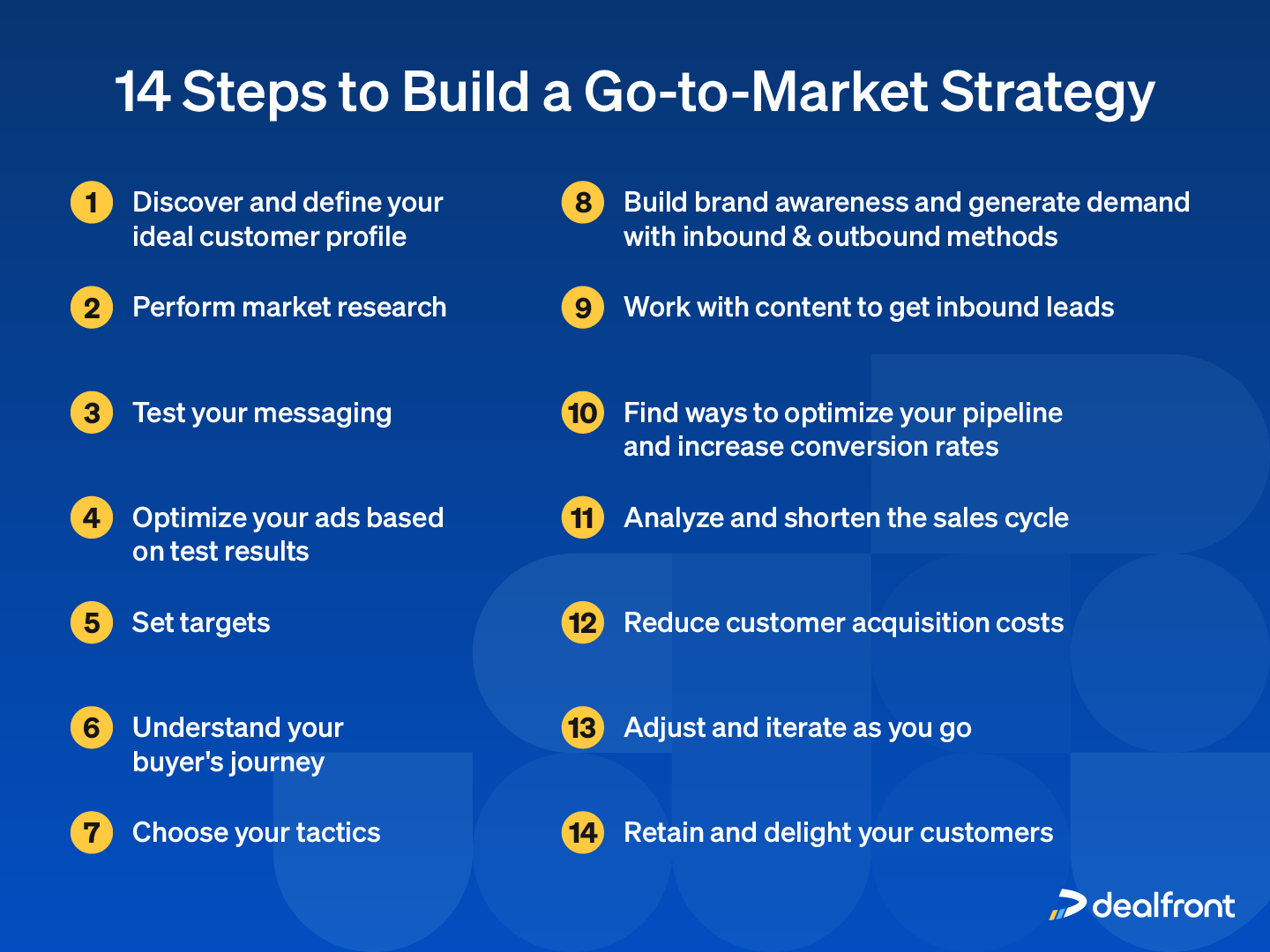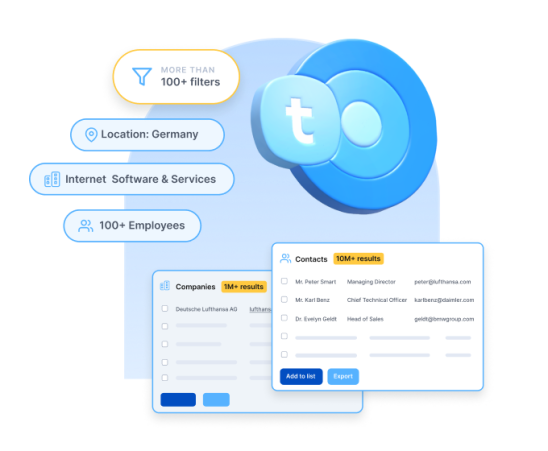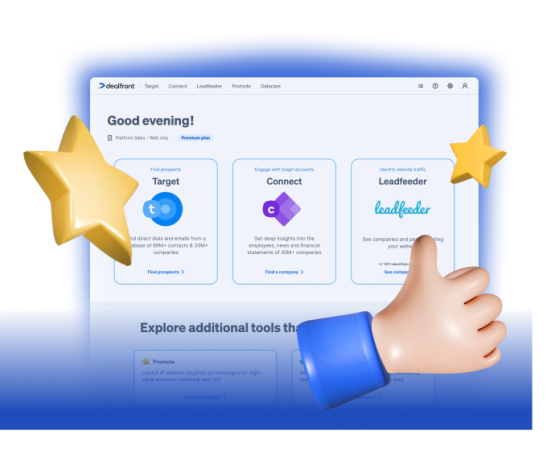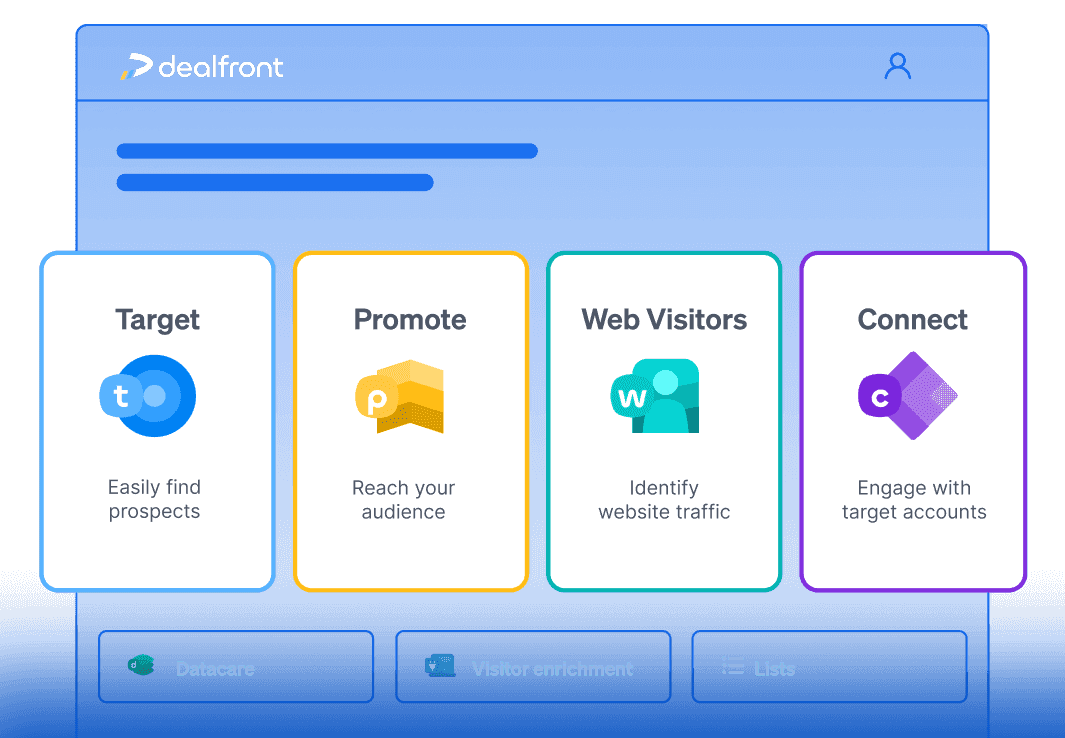If you've ever launched a new product or service, you already know that it'll take more than just waiting around to see if potential customers show interest. Developing a solid go-to-market (GTM) strategy to help launch your offering is absolutely critical.
Your big launch may seem great on paper, but if you haven’t done the prep work you’re setting yourself up to fail. When you’re done reading you’ll be equipped with all the strategies you need to position your product or service as the go-to solution for your prospective customers.
What exactly is a go-to-market strategy?
A GTM strategy is a plan to help organizations launch new products and services, or when they want to enter a new market. This strategy will make sure you’re launching the right product, for the right audience, at the right time, at the right price. It will also allow you to anticipate the potential challenges and outline your sales and distribution channel strategies.
Who should have a GTM strategy?
Everyone looking to introduce their offerings to a new market should have a robust GTM strategy prepared.
How can a GTM strategy benefit your business?
Understanding the marketplace, the target market, and the product's place within it
Minimizing marketing costs by figuring out which promotional channels offer the highest ROI (return on investment)
Troubleshooting product messaging and positioning in advance
Outlining the logistics of sales and distribution so you can get the maximum market impact
Now you know why you should have a robust go-to-market strategy, let’s break down how that all looks in practice.
Types of go-to-market strategies
There's no one-size-fits-all approach to GTM strategies. You’ll need to decide on your strategy based on your product and how people will best receive it.
Ideally, your product strategy should use a combination of the following strategy types to maximize ROI.
Inbound Marketing
Inbound marketing creates brand awareness to bring in new prospects organically, and it can be very powerful. The goal is to get attention from the right audience at every stage of the customer journey.
Strategies focusing on inbound marketing use many forms of marketing, and usually include:
Search engine optimization (SEO)
Local events
Blog posts
Because prospects must find your content and eventually funnel it to the product or service, this strategy usually pays off in time. But, with a paid media campaign, like social media ads, you can speed up its ROI.
Sales enablement
Sales enablement strategies focus on training and coaching salespeople at every sales cycle stage. They include the tools and content to train sales teams so they can efficiently sell more products.
Sales enablement is a convenient component of any marketing strategy—even if it's not the main focus. Recent data from McKinsey shows that 68% of B2B buyers see one-on-one meetings with sales reps as an indicator of how much you value your relationship with them.
Sales enablement helps your reps bridge the gap between being just a salesperson, and being a trusted advisor to your customer, creating a more personalized experience. For more information about sales enablement tools, click here to find out how they can help your business perform better.
Demand generation
The name says it all. Demand generation strategies help keep your product or service top of mind for those customers who aren’t currently buying. Why? This strategy helps keep them engaged and interested in what you have to offer until they’re ready to buy.
Demand generation strategies are focused on helping your customers learn from you. Good examples of ways you can educate and engage your customers can include:
Newsletters
Webinars
Blog posts
Social media posts
Your goal should be to anticipate the questions your customers might have at this stage of their journey with you. It helps you stay relevant and position you as a trusted thought-leader they want to continue doing business with.
Account-based marketing
ABM (account-based marketing) focuses on closing sales deals with high-value accounts before your product launch. As a result, account-based marketing strategies revolve around B2B marketing.
For a successful ABM campaign, marketing and sales teams must align their efforts to find, target, and eventually close deals with these high-value accounts. This method can require more proactive work since you'll need to engage with each account to understand and address their needs and pain points. But 72% of marketers said ABM delivers the highest ROI of all marketing types in a recent survey, so the effort pays off well if you can close the deals.
Components of a good digital go-to-market strategy
While there isn’t a magic formula to ensure 100% success, here are the 5 components that should definitely be a part of your GTM strategy:
Product: What value does your offering provide your prospective customers?
Channels: How will you reach customers?
Customers: Who will buy your product? The customers should be the focus of any great GTM strategy.
Messaging: How will you market the product to customers so that it's ideal for them?
Partners: Who else will you work with to make your GTM strategy more effective? This can include distributors, service providers, and resellers.
Asking yourself these questions will help you have a clearer vision of how you can best serve your customers and build sustainable relationships.
14 steps to build a go-to-market strategy
Once you determine that your product or service fits the market, you’ll want to create your GTM strategy.
We’ve outlined 14 steps to help you get started:
1) Discover and define your ideal customer profile
Begin by defining who you want to sell to. You probably have a rough idea, but the more specific and detailed you can make your ideal customer profile and buyer personas, the better.
The first step is to define the target market that you want your product to reach. Then, you can segment the target market to focus on more specific groups that will find your product most valuable.
There are many ways you can segment customers, like:
Demographic data: Can you group your customers according to age, gender, job, or location?
Customer behavior: Do you notice trends in buyer behavior, like when they make a purchase, how much they spend, or which products they look at on your site?
Customer needs: Will many customers use your product to solve similar problems?
Media channels: Where can you reach the majority of your ideal customers?
Tracking customer behavior also helps you identify the best ways to upsell and cross-sell to your shoppers. Your website host likely gives insight into how customers use your site, but Leadfeeder offers a much deeper analysis. It has the highest company recognition rate on the market in compliance with General Data Protection Regulation (GDPR) legislation and offers over 50 filters that help you identify buying intent.
After segmenting your customers, you can build ideal customer profiles (ICPs) describing the companies that would benefit from your solution. You can identify the accounts most likely to buy your product and focus on targeting them. If your product would be best for small- or medium-sized businesses trying to optimize their pipeline, you can save time and money by targeting them.
Your ICP should cover the relevant characteristics of the accounts you're targeting, like:
Industry
Size
Revenue
Location
Budget
Number of customers
Organizational level
Technological maturity
Dealfront's Target tool can enhance the effectiveness of your ICP by building lists of companies that correspond to it and finding their key decision-makers' contacts. That way, you can optimize your efforts by focusing on accounts that best match your ICP.
Defining your target audience and drawing up ICPs may take time, but it can significantly raise your ROI.
2) Perform market research
It's easy to feel like you need to build a strategy from the ground up, or maybe you already have one in mind. But, by researching the best examples of go-to-market strategies that other companies in your field have tried, you can save a lot of time and effort.
Dig deep into your and your competitors' GTM strategies. Figure out what worked and what didn’t. If a particular method had solid results, consider whether there's a way you can build on it to get even better results.
This is also the point where you should figure out your pricing strategy. What pricing system do successful products within your niche use? If they tend to have a freemium structure, customers will likely be reluctant to try a similar product that doesn't let them access any handy features for free. Think about how to offer a more attractive price structure than competing products.
3) Test your messaging
Your value proposition tells customers what they will get from buying your product. It's best to make a unique value proposition for each buyer persona since they should all have different pain points, wants, and needs.
To ensure that you've mapped messaging to each persona, it helps to put together a messaging matrix. This is an itemized list, where each entry covers:
A buyer persona
Their pain points
How your product solves these problems
A key message that communicates the solution.
Once you decide on a value proposition for each persona, you should test them to make sure they actually appeal to the people you want to reach. You don't want to spend significantly on an ad campaign to discover you didn't connect with your target audience.
A simple way to test your messaging is by setting up a basic landing page and then running a cold outreach campaign with your messaging. Leadfeeder can help you gather visitor data that you can then evaluate.
It also helps to use A/B testing—running two different propositions for the same buyer persona to see which works better. That way, you can identify why one worked better and improve your messaging accordingly.
4) Optimize your ads based test results
Once you see the reach of your cold campaign, you can optimize your messaging to boost your ads' conversion rates. If you used A/B testing, think about what made one campaign appeal to viewers more than the other. The two common areas to improve in your value proposition are:
Focus: It's common to overgeneralize your messaging, but the best value propositions focus only on solving the pain point for the niche they're targeting.
Solving a problem: Sometimes, even if you address the right pain point, your value proposition can fail to show how your product will solve the problem.
If you want to take the guesswork out of the process, you can include a survey that asks visitors what they expect from your product based on your messaging.
Similarly, you can also test ads that you make for each persona. It helps to keep one as a control and make a few variants with only one or two changes from the control. You can then evaluate and improve based on the one that gets the most attention.
5) Set targets
Now that you have an idea of your messaging outreach, you can set targets for your product launch to evaluate your go-to-market strategy framework's performance. Depending on your business needs, various frameworks can help you set solid, measurable targets. These are some of the best, which you can use on their own or combine:
SMART goals: SMART stands for specific, measurable, achievable, realistic, and time-bound. Objectives that fit these criteria are easy to evaluate and adjust based on the evaluation results.
Key performance indicators (KPIs): KPIs are metrics quantifying your progress towards specific business objectives. For example, you could evaluate your GTM strategy based on the total purchases and ad click-throughs your new product gets. The SMART framework is good to keep in mind when setting KPI goals.
Objectives and key results (OKRs): This strategy groups the goals you want to achieve with the results you want to use to know if you succeeded. Each OKR should follow the format, "I will [objective] as measured by [key result]." This gives you clarity on which metric to track for which goal.
It's important to remember that outbound and inbound strategies will yield much different results. Typically, an outbound approach will get many more impressions but convert fewer than an inbound strategy. However, inbound strategies often take longer to realize value.
6) Understand your buyer’s journey
The customer journey maps all points of contact or touchpoints that a customer comes across from when they learn about your brand until they make a purchase. To understand your buyers' journeys, you can make a customer experience map to comprehend how customers experience their journey toward buying your product or reaching out for a free trial or demo.
The map should cover the five essential phases customers undergo when interacting with a brand or product:
Awareness: Customers have realized they have a problem they want a solution to. They may not know yet that they need a product or service to solve it, but they will start researching. Touchpoints here are informational, offering potential solutions to readers but not directly encouraging a purchase. Therefore, you can try to get customers' contact information to continue to remind them of your brand or product.
Consideration: Now, customers have done enough research to know a product can solve their problem, so they're comparing products. Here, you require marketing touchpoints that separate your product from the crowded marketplace they're trying to navigate. For example, you could post your customer success stories on social media.
Decision: Customers are now ready to make a purchase. Touchpoints at this point should be direct, encouraging the buying process and maybe even including a discount code to entice the customer.
Retention: Once customers have purchased a solution, they're in the retention stage, where they stay with the company they bought from instead of switching to a competitor. Here, you should offer a good onboarding experience and ongoing customer service to show the customer that you want them to get the most out of their purchase.
Loyalty: This final stage is always ongoing, where customers don't just choose to stay with your company but actively promote it to their family, friends, and colleagues as brand advocates. Touchpoints of this stage, like a referral program, aim to simplify and encourage these loyal customers' efforts.
Identify your touchpoints for each stage and evaluate how well they do their job. Improving them will have a noticeable effect on your ROI.
7) Choose your tactics
Now, you need to determine how you want to sell your product. Should customers be able to find it on their own and pick it up, or do you want sales reps to guide prospects to the product that's perfect for them? Here are some of the most common sales models to consider.
The self-service model
This is a frequent model in e-commerce, where customers buy your product independently. It makes a convenient approach for go-to-market strategies for startups because it doesn't require a dedicated sales team. But, if you adopt the self-service model, be ready to invest a lot into inbound driving traffic to your website.
The inside sales business model
An inside sales business model has a sales team to nurture prospects and convince them to buy something. Your sales team could offer free demos or consultations to nudge the customer along their path to discovering value. This option works well if you have products with a medium price point that are a bit more complex, like collaborative video or image editing software.
The field sales business model
In this model, common for ABM, salespeople aim to close big enterprise deals. The field sales business model has a longer sales cycle and needs a more significant sales investment, but you can complete much larger contracts. Because your salespeople must build a deeper relationship with prospective customers, you also retain more customers.
The channel model
In this model, you select an external partner to sell your product for you. It's convenient because you can offload your sales costs, making it the cheapest model, but you will also have less control over how you market your product. For example, if you place an app on the App Store, you have limited control over the reviews on its page.
8) Build brand awareness and generate demand with inbound & outbound methods
Now, it's time to start generating customer demand in the awareness stage for your upcoming product. Remember, at this point, customers are aware they have a problem but don't know how to solve it, so you need to offer them valuable solutions that endear them to your brand.
Some inbound marketing tactics you can use to build brand awareness include:
SEO: The first place people go when they want to solve a problem is Google. But very few people click on results lower on the results page. SEO helps ensure your website and solutions become the first results the prospect opens.
Social media: Since almost everyone is on social media now, companies with a heightened social media presence can easily increase their brand equity and raise their trust and credibility with prospects.
After you try out these tactics, you can switch to outbound marketing to build brand awareness further. Some tactics to try include:
Cold emails: People are quick to hang up on cold callers these days, but they will at least read the subject line on a cold email. If you can draft cold emails that feel personal, offer value, and have compelling subject lines, you can reach many people who don't know about your brand.
Direct mail: Using snail mail in the digital age can feel strange. But think about how excited you are when you get a letter with your name in the mail. A personalized ad that stands out against the other spam letters people get can make you stick in their minds much longer than any online ad.
9) Work with content to get inbound leads
Your inbound marketing works like a funnel, where you cast a wide net and then pull people in. Different content at each level of this funnel—top, middle, and bottom—can help maximize the number of people making a purchase.
Top-of-funnel content
Content at this level aims to build brand awareness. SEO, paid ads, and blog content are great tools for this. Since you're trying to capture the attention of people who fit your target audience, you should evaluate this content against your buyer personas for effectiveness. You should also use this content to collect contact information and push leads further along the funnel.
Middle-of-funnel content
Now, you can nurture leads to keep your business at the front of their minds until they're ready to make a purchase. To keep people engaged, offer consistent, useful informational content like eBooks, whitepapers, and case studies.
Bottom-of-funnel content
Finally, customers are at the decision stage and need one final push to complete the purchase. You should send them content that motivates them to buy your product, like trial extensions, demos, or discount offers.
10) Find ways to optimize your pipeline and increase conversion rates
Once people begin moving through your sales funnel and buying your product or service, you can optimize your pipeline. Leadfeeder can help your marketing teams determine where people spend a lot of time and which touchpoints people tend to bounce from.
Try to shorten the customer journey as much as possible so customers only need to reach a few key touchpoints to purchase. This decreases churn and boosts conversion rates.
11) Analyze and shorten the sales cycle
Reducing the time you need to turn leads into customers will help save money while realizing a profit. Take a look at your sales process and see if you can find ways to optimize it, such as:
Automate repetitive tasks for increased efficiency
Be open about pricing early on, so prospects can decide early on if your product is a good fit for them
Simplify the process for prospects to sign a contract from any device
Regularly clear cold leads from your list of potential targets
Give each prospect a personalized experience
Explore prospects' concerns before responding to them
12) Reduce customer acquisition costs
Getting as many buyers as possible is useful, but not if the cost of acquiring each is high. Increasing ROI means lowering your customer acquisition cost, which you can do with several tactics, like:
Identifying high-quality leads based on the actions that previous ideal customers took
Retargeting prospects who have left incomplete actions on your touchpoints so they don't fall out of the funnel
Offering affiliate partner programs to offload some of your marketing burdens
Creating effective content, since the content is a one-time investment that lasts online forever.
13) Adjust and iterate as you go
While you're executing your strategy, you should be monitoring the performance of your different tactics. It's not enough to put everything in motion and hope it works—you need to make proactive changes to improve your campaign.
For example, if YouTube is a part of your campaign, consider a couple of alternative titles when you publish a new video. It's impossible to know if the first title you chose will get picked up by the algorithm, so changing it on an underperforming video could get it the views it deserves.
14) Retain and delight your customers
Finally, you should maintain a good relationship with your customers after their purchase to retain their business. Otherwise, you'll have to send another prospect through your customer journey to get more business.
You need to show customers that you care about them getting value from the product, not just their money. Some areas to focus on to do this include:
Reverse logistics: This encompasses the processes that enable customers to return or refund a product that doesn't work or solve their problem. Few people will want to risk doing more business with you if you have a challenging return process.
Product onboarding: Your onboarding process should arm customers with the knowledge to discover the value of your product as quickly as possible without feeling overbearing or pushy.
Customer support: If people have a problem with your product, they want to be able to reach out and get a quick response on how to fix it.
Here’s a handy summary of all the steps:

Create the best go-to-market sales strategy for your product
It seems like a lot, we know. But, having a strong B2B go-to-market strategy helps you attract as many people as possible to your product and maximize your ROI. And at the end of the day, you want to do as much as you can to boost your success.
Now that you understand how to build and execute your GTM strategy, you can draw up a go-to-market strategy template that helps you map out the best product launch you can make.
Since GTM strategies require such a strong customer focus, collecting insights on your customers before and during your strategy's execution will significantly enhance it. Dealfront's tools, like Leadfeeder and Target, enable you to better identify and target your ideal customers so that you can make sure your products get into the right hands. Book yourself a Dealfront demo to see how much more you can get from your product's go-to-market strategy.









